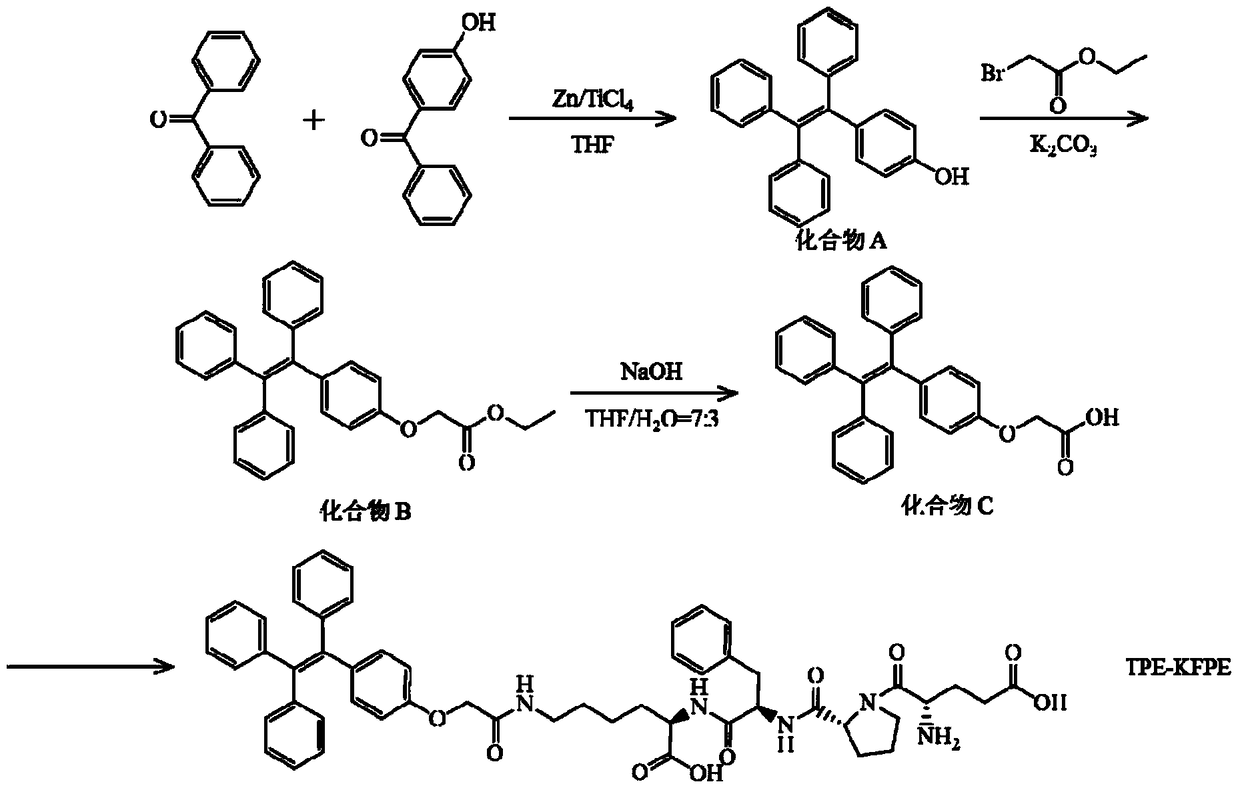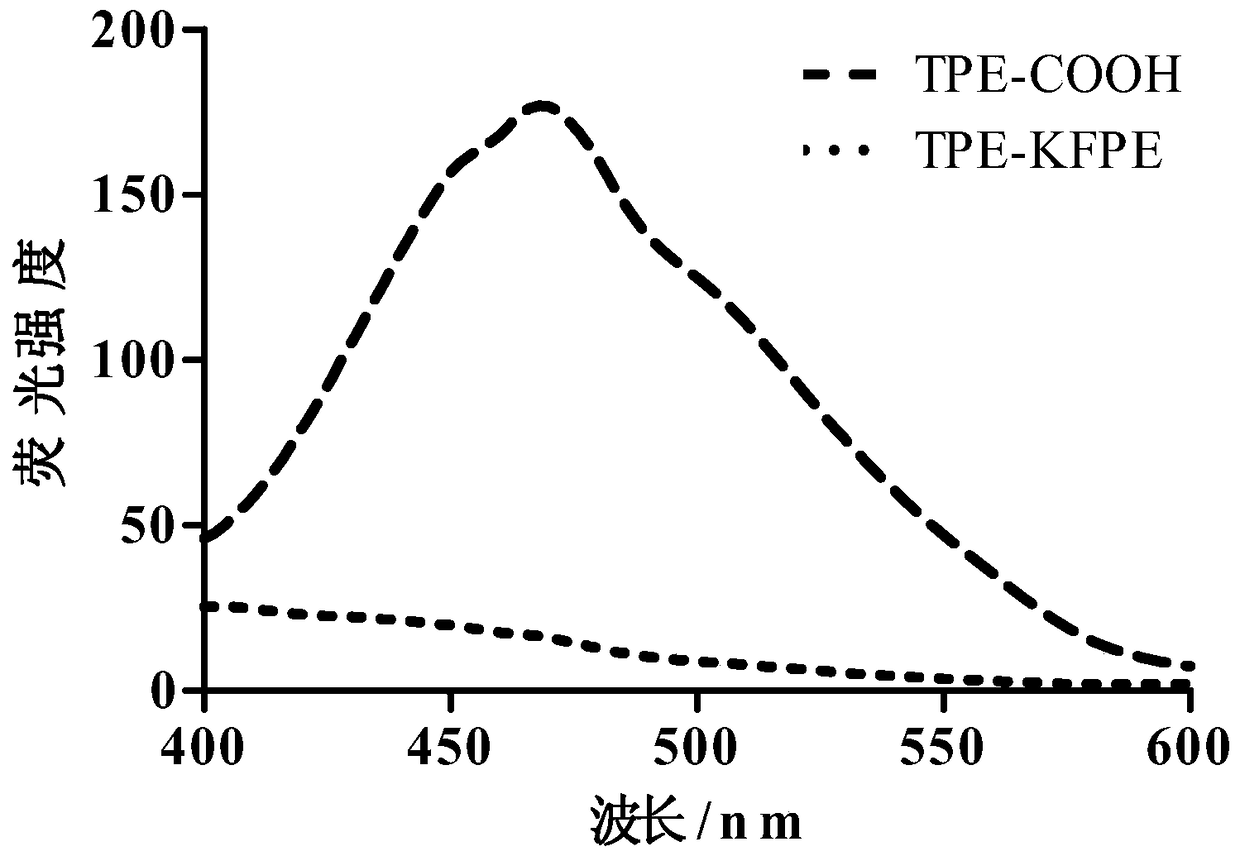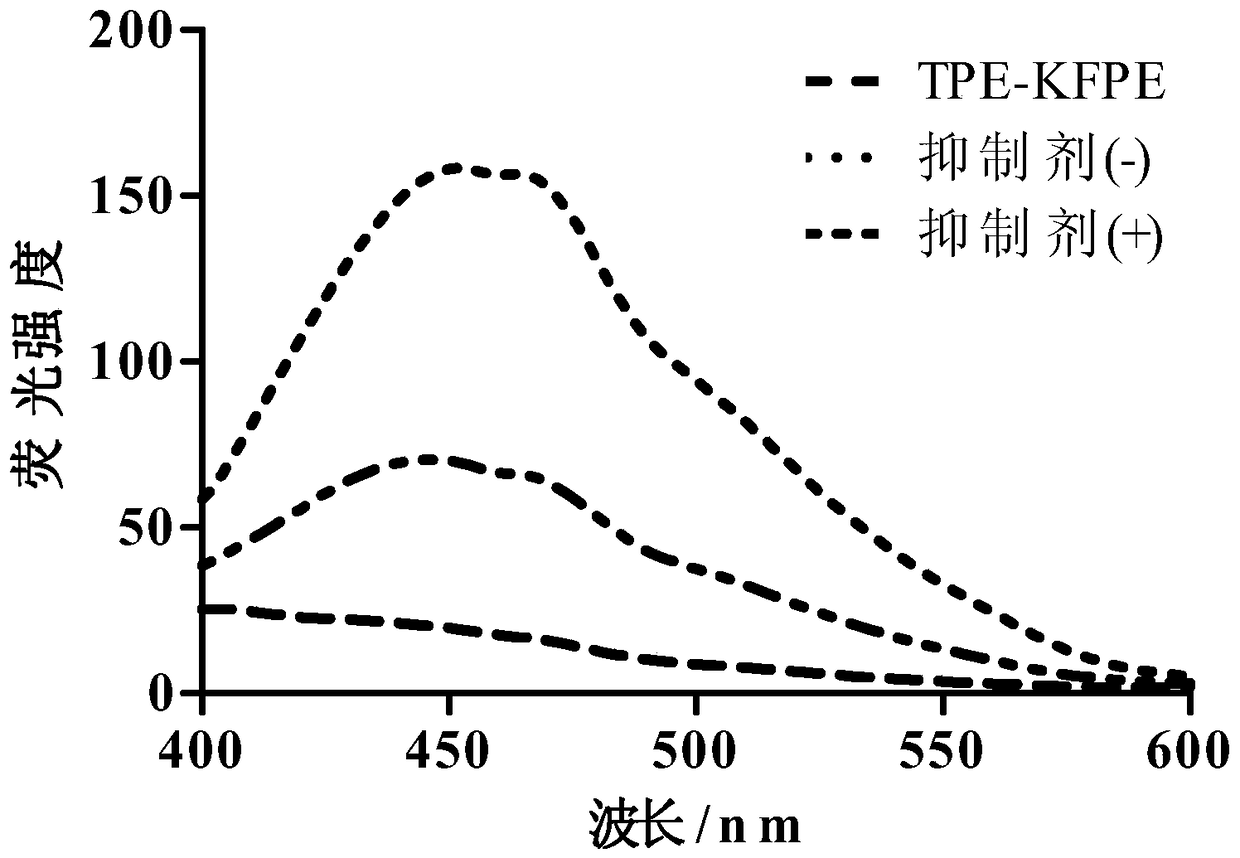A polypeptide for dpp-4 detection and a fluorescent probe comprising the polypeptide
A DPP-4, fluorescent probe technology, applied in the field of fluorescent probes
- Summary
- Abstract
- Description
- Claims
- Application Information
AI Technical Summary
Problems solved by technology
Method used
Image
Examples
Embodiment 1
[0047] Embodiment 1 has the fluorescent probe synthesis of AIE characteristic
[0048] A kind of synthetic method of the fluorescent probe with AIE characteristic of this embodiment, its synthetic procedure is as follows figure 1 shown, including:
[0049] (1) Separately synthesize a polypeptide chain through a solid-phase polypeptide synthesis reaction, and the sequence of the polypeptide chain is glutamic acid-proline-phenylalanine-lysine;
[0050](2) Add 4-hydroxybenzophenone (1.9g, 10mmol), benzophenone (2.2g, 12mmol) and zinc powder (2.9g, 44mmol) into a 250ml three-necked flask, pump air, nitrogen, and repeat three times; Add 80ml of THF (tetrahydrofuran), 0 ℃ ice-water bath for 30min; dropwise add titanium tetrachloride (2.4ml, 22mmol) under ice-water bath, reflux overnight, spin dry; add appropriate amount of dichloromethane and dilute hydrochloric acid for extraction, remove the organic layer, dried with anhydrous magnesium sulfate, filtered, spin-dried, and subject...
Embodiment 2
[0055] Example 2 Application of Fluorescent Probe TPE-KFPE in DPP-4 Activity Detection
[0056] Detection of DPP-4 activity with fluorescent probe TPE-KFPE
[0057] Sample group 1: add 5 μL TPE-KFPE (1mM);
[0058] Sample group 2: add 25μL DPP-4 (100mU / mL), 5μL TPE-KFPE (1mM);
[0059] Sample group 3: Add 25μL DPP-4 (100mU / mL), 5μL TPE-KFPE (1mM), 2.5μL inhibitor Diprotin A (1mM);
[0060] The three sample groups were incubated at 37°C for 30min. After the reaction, a JASCO FP-6500 spectrophotometer was used to measure the fluorescence spectrum from 400 nm to 600 nm under 320 nm excitation.
[0061] Test results such as image 3 shown.
[0062] Depend on image 3 It can be seen that before the addition of DPP-4, the system only contained fluorescent probes, and the fluorescence intensity was low; after the addition of DPP-4, the fluorescence intensity of the system increased rapidly; when the DPP-4 inhibitor Diprotin A was added to the system, the fluorescence intensity ...
Embodiment 3
[0064] Example 3 Application of Fluorescent Probe TPE-KFPE in Screening DPP-4 Inhibitors
[0065] (1) Application of fluorescent probe TPE-KFPE in screening DPP-4 inhibitors
[0066] Take 1 μL fluorescent probe TPE-KFPE (1 mM), add 5 μL DPP-4 (100 mU / mL) and a certain volume of Diprotin A mother solution with different concentrations (making the final concentration of Diprotin A 0.005, 0.025, 0.05, 0.1, 0.2, 0.5, 5 , 10, 20, 50, 100 μM), make up to 100 μL with buffer solution HEPES pH 7.0, incubate at 37°C for 30 minutes and measure with a Tecan microplate reader, set E x 320nm (±25nm), E m 450nm (±25nm).
[0067] See the test results Figure 5 .
[0068] Depend on Figure 5 It can be seen that with the increase of the concentration of Diprotin A, the inhibitory effect of Diprotin A on DPP-4 also gradually increases; indicating that the fluorescent probe TPE-KFPE can better reflect the inhibitory effect of the inhibitor on DPP-4, and can be used for DPP-4 Inhibitor scree...
PUM
 Login to View More
Login to View More Abstract
Description
Claims
Application Information
 Login to View More
Login to View More - R&D
- Intellectual Property
- Life Sciences
- Materials
- Tech Scout
- Unparalleled Data Quality
- Higher Quality Content
- 60% Fewer Hallucinations
Browse by: Latest US Patents, China's latest patents, Technical Efficacy Thesaurus, Application Domain, Technology Topic, Popular Technical Reports.
© 2025 PatSnap. All rights reserved.Legal|Privacy policy|Modern Slavery Act Transparency Statement|Sitemap|About US| Contact US: help@patsnap.com



